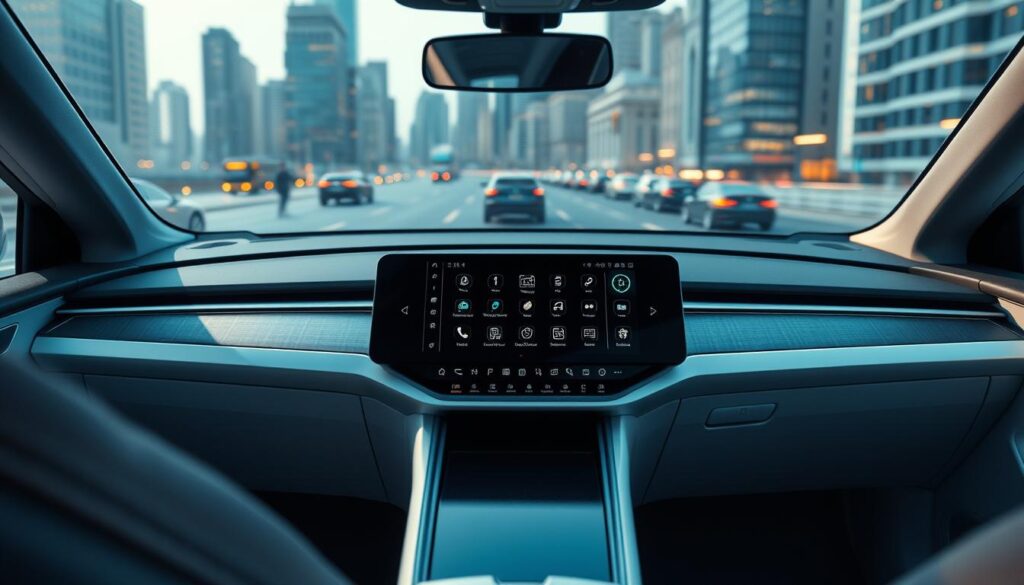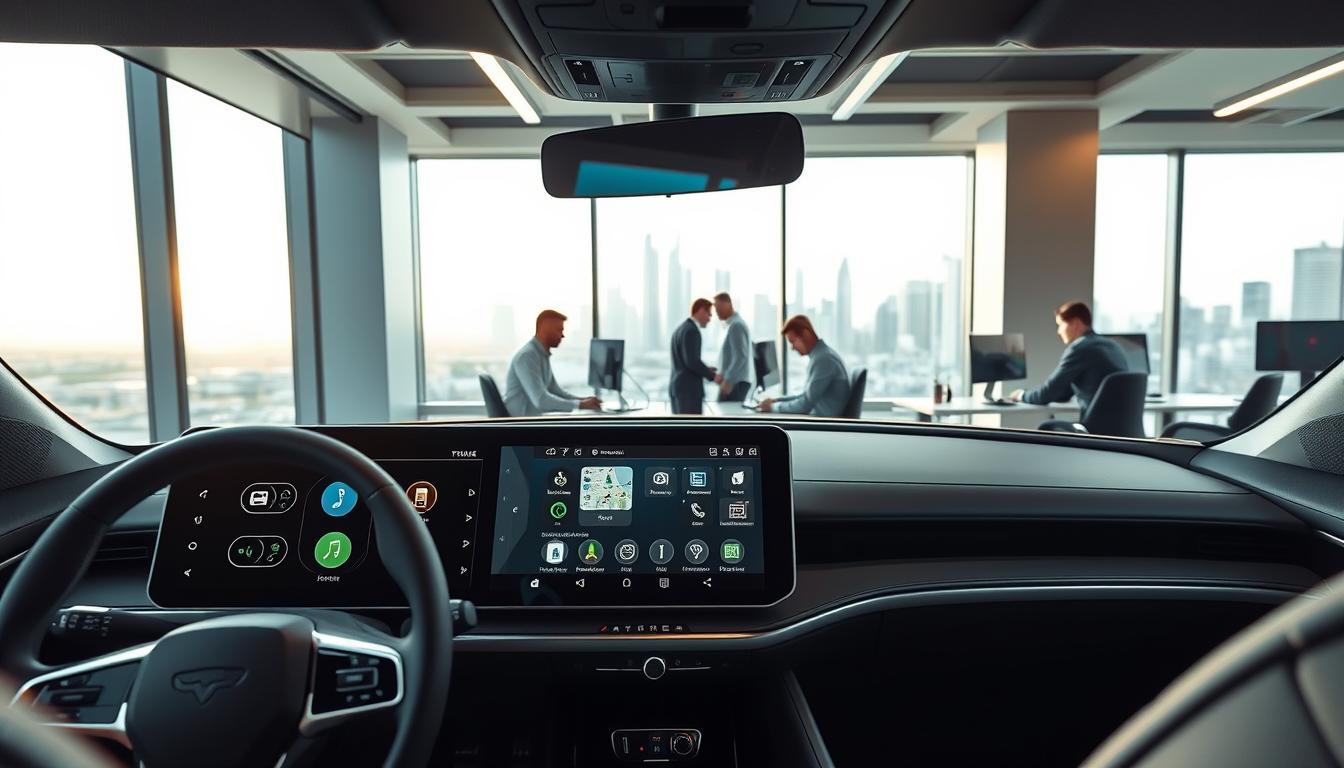The automotive industry is undergoing a significant transformation, with Human-Machine Interface (HMI) playing a crucial role in enhancing the driver and passenger experience.
As cars become increasingly sophisticated, the demand for advanced HMI solutions is on the rise. The automotive HMI market is projected to grow from USD 23 billion in 2023 to USD 49.43 billion by 2030, driven by the need for improved safety, comfort, and connectivity.
Germany, being a hub for the automotive industry, is home to several leading HMI manufacturers that are shaping the future of vehicle interaction.
Key Takeaways
- Germany is a leading hub for automotive HMI innovation.
- The global automotive HMI market is expected to reach USD 49.43 billion by 2030.
- Advanced HMI solutions are driving improved safety and comfort in vehicles.
- Leading HMI manufacturers in Germany are at the forefront of industry trends.
- The role of HMI in the automotive industry is becoming increasingly critical.
Overview of Human-Machine Interfaces (HMIs) in the Automotive Industry
HMIs are revolutionizing the way drivers interact with their vehicles, providing a more intuitive and personalized driving experience. The integration of advanced HMIs is transforming the automotive landscape, enhancing both safety and user experience.
Definition and Importance of HMIs
Human-Machine Interfaces (HMIs) in the automotive industry refer to the systems that enable drivers and passengers to interact with their vehicle’s functions. These interfaces include various components such as touchscreens, voice recognition systems, and gesture control interfaces. A well-designed HMI is crucial as it significantly reduces driver distraction, improves vehicle safety, and provides personalization options.
The importance of HMIs lies in their ability to seamlessly integrate complex technological features into a user-friendly environment. By doing so, they enhance the overall driving experience, making it safer and more enjoyable. For instance, advanced HMI solutions allow drivers to control infotainment systems, navigate through menus, and access vital vehicle information without taking their eyes off the road.
Role of HMIs in Modern Vehicles
In modern vehicles, HMIs play a pivotal role in integrating advanced driver-assistance systems (ADAS) and infotainment systems. They provide drivers with real-time information and control over various vehicle functions, thereby enhancing safety and convenience. For example, HMIs can display critical safety alerts, navigation instructions, and vehicle diagnostics, ensuring that drivers are always informed.
The role of HMIs extends beyond mere functionality; they are also a key differentiator for automotive manufacturers. By offering intuitive and feature-rich HMIs, manufacturers can enhance the driving experience, setting their vehicles apart in a competitive market.
| HMI Feature | Description | Benefit |
|---|---|---|
| Touchscreen Displays | Interactive screens that allow users to control various vehicle functions. | Enhanced user experience and reduced driver distraction. |
| Voice Recognition Systems | Systems that allow drivers to control functions using voice commands. | Increased safety by minimizing manual interactions. |
| Gesture Control Interfaces | Interfaces that allow users to control functions through gestures. | Provides a futuristic and intuitive way to interact with the vehicle. |
Key Features of Automotive HMIs
Advanced Human-Machine Interfaces (HMIs) are becoming a standard in modern vehicles, enhancing user experience and safety. These interfaces are crucial in providing drivers with a seamless and intuitive way to interact with their vehicles.
Touchscreens and Displays
Touchscreens and high-resolution displays are among the key features of modern automotive HMIs. In-car display manufacturers are continually innovating to provide clearer, more responsive, and feature-rich interfaces. These touchscreens allow drivers to control various vehicle functions, from navigation to entertainment systems, with ease.
Voice Recognition Systems
Voice recognition systems represent another significant advancement in automotive HMIs. These systems enable drivers to perform tasks without taking their hands off the wheel or eyes off the road, enhancing safety. Voice commands can be used for making calls, sending messages, or adjusting the vehicle’s climate control.
Gesture Control Interfaces
Gesture control interfaces are an emerging feature in some automotive HMIs, allowing drivers to control certain functions with hand or finger gestures. This technology is still in its early stages but promises to further enhance the driving experience by reducing the need for physical controls.
The integration of these features into automotive HMIs is not only about enhancing the user experience but also about improving safety and reducing driver distraction. As technology continues to evolve, we can expect to see even more sophisticated HMIs in the future.
Leading HMI Manufacturers in Germany
Leading the charge in automotive HMI technology are several German companies that have been at the forefront of innovation, shaping the future of in-vehicle interfaces. These manufacturers are not only enhancing user experience but also driving the industry towards more sophisticated and integrated solutions.
Continental AG
Continental AG is a prominent player in the automotive HMI sector, known for its advanced technologies that improve vehicle safety and user interaction. Their HMIs are designed to be intuitive, providing drivers with seamless access to vital information.
Innovative Features: Continental’s HMIs often incorporate advanced touchscreens, voice recognition, and gesture control, setting a new standard for in-car interfaces.
Bosch Mobility Solutions
Bosch Mobility Solutions is another key manufacturer that is revolutionizing the automotive HMI landscape. Their focus on integrating HMIs with other vehicle systems enhances overall driving dynamics and safety.
“The future of driving is not just about getting from point A to point B; it’s about creating an immersive experience that combines safety, comfort, and connectivity.”
Their HMIs are designed to be highly customizable, allowing drivers to personalize their interface according to their preferences.
Harman International
Harman International, known for its premium audio solutions, has also made significant strides in the HMI domain. Their technologies aim to create a more connected and enjoyable driving experience.
- Advanced audio and infotainment systems
- Integration with smart devices for enhanced connectivity
- User-centric design approaches for intuitive interfaces
| Manufacturer | Key HMI Features | Innovation Focus |
|---|---|---|
| Continental AG | Touchscreens, Voice Recognition, Gesture Control | Safety and User Interaction |
| Bosch Mobility Solutions | Integrated HMIs, Customizable Interfaces | Driving Dynamics and Safety |
| Harman International | Advanced Audio, Smart Device Integration | Connected and Enjoyable Driving Experience |
These leading HMI manufacturers in Germany are not only pushing the boundaries of what is possible in automotive technology but are also setting new benchmarks for the industry worldwide.
Emerging HMI Technologies
Emerging HMI technologies are set to transform the driving experience, offering unprecedented levels of interaction and safety. As the automotive industry continues to evolve, these innovations are poised to play a crucial role in shaping the future of vehicle design and user experience.
Augmented Reality and HMIs
Augmented reality (AR) is revolutionizing the way drivers interact with their vehicles. By overlaying digital information onto the real world, AR enhances the driving experience, providing drivers with critical information at a glance. For instance, AR can display navigation directions directly on the windshield, reducing the need for drivers to look away from the road.
HMI technology providers are increasingly incorporating AR into their solutions, enabling a more intuitive and engaging driving experience. This technology has the potential to significantly reduce driver distraction, improving safety on the roads.

Biometric Interfaces
Biometric interfaces represent another significant advancement in HMI technology. By using biometric data such as facial recognition, voice patterns, and even driver fatigue levels, vehicles can offer personalized experiences and enhance safety. Biometric interfaces can adjust vehicle settings based on the driver’s preferences and monitor their condition to prevent accidents.
The integration of biometric interfaces into vehicles is expected to grow, driven by advancements in sensor technology and data analysis. This will enable HMI technology providers to offer more sophisticated solutions that cater to the individual needs of drivers.
Adaptive User Interfaces
Adaptive user interfaces are designed to adjust their layout and functionality based on the driver’s behavior, preferences, and context. This adaptability ensures that the driving experience is optimized for comfort, safety, and convenience. For example, an adaptive interface might simplify the infotainment system when the vehicle is in motion, reducing driver distraction.
By leveraging machine learning algorithms, HMI technology providers can create adaptive interfaces that learn from the driver’s habits, offering a more personalized and intuitive driving experience. This technology is set to become increasingly prevalent as the automotive industry moves towards more sophisticated and user-centric HMI solutions.
Market Trends in the Automotive HMI Industry
The future of automotive HMIs is being shaped by several key market trends that are redefining the industry. As technology continues to advance, the demand for more sophisticated and user-friendly interfaces is on the rise.
Increased Demand for Connectivity
The automotive industry is witnessing a significant shift towards connected vehicles, with HMIs playing a crucial role in this transition. The increased demand for connectivity is driving HMI manufacturers to develop interfaces that can seamlessly integrate with various devices and services.
- Enhanced infotainment systems
- Integration with smartphones and wearables
- Real-time traffic updates and navigation
Focus on User-Centric Design
There’s a growing emphasis on designing HMIs that are intuitive and user-friendly. Manufacturers are focusing on creating interfaces that minimize driver distraction while providing essential information and entertainment.
“The key to successful HMI design lies in understanding the needs and preferences of the end-user.”
Integration with Autonomous Driving Technology
As autonomous vehicles become more prevalent, HMIs are being designed to adapt to the changing driving experience. This includes developing interfaces that can communicate the vehicle’s status and intentions to both the driver and passengers.
Key features include:
- Clear communication of vehicle status
- Personalized experiences for different users
- Seamless transition between manual and autonomous modes
Regulatory Standards and Compliance
Regulatory compliance is a critical aspect for HMI manufacturers operating in Germany’s automotive sector. Ensuring that HMIs meet the required safety and environmental standards is not only a legal necessity but also a crucial factor in maintaining consumer trust and avoiding costly recalls.
Safety Requirements for Automotive HMIs
Automotive HMIs must adhere to stringent safety requirements to minimize distractions while driving and ensure that the driver’s attention remains on the road. The German Federal Motor Transport Authority (KBA) and other regulatory bodies have established guidelines that HMI manufacturers must follow.
Some key safety requirements include:
- Limiting the complexity of HMI interfaces to avoid driver distraction
- Ensuring that critical functions are easily accessible and understandable
- Implementing voice command systems to reduce manual interactions
For instance, Continental AG, a leading HMI manufacturer, has developed HMIs that comply with these safety standards by incorporating advanced voice recognition and minimizing visual clutter.
Environmental Regulations in Germany
Germany is known for its rigorous environmental regulations, and automotive HMI manufacturers are not exempt from these requirements. The European Union’s Restriction of Hazardous Substances (RoHS) Directive and the Waste Electrical and Electronic Equipment (WEEE) Directive are two key regulations that impact HMI production.
To comply with these regulations, manufacturers must:
- Reduce the use of hazardous substances in HMI components
- Implement environmentally friendly disposal and recycling practices
| Regulation | Description | Impact on HMI Manufacturers |
|---|---|---|
| RoHS Directive | Restricts the use of hazardous substances in electronic equipment | Requires the use of lead-free solders and reduction of other hazardous materials |
| WEEE Directive | Promotes the recycling and proper disposal of electronic waste | Manufacturers must design HMIs for recyclability and ensure proper disposal practices |
By adhering to these regulatory standards, HMI manufacturers in Germany not only comply with the law but also contribute to a safer and more sustainable automotive industry.
Challenges Faced by HMI Manufacturers
As the automotive landscape evolves, HMI manufacturers must overcome obstacles related to technological innovation and user data protection. The rapid pace of change in the automotive industry presents significant challenges for HMI manufacturers, particularly in Germany, where the market is highly competitive and technologically advanced.
Adapting to Rapid Technological Changes
The automotive HMI sector is characterized by rapid technological advancements, including the integration of artificial intelligence, augmented reality, and advanced driver-assistance systems (ADAS). To remain competitive, HMI manufacturers must invest heavily in research and development to keep pace with these changes.
Some of the key technological challenges include:
- Developing HMIs that can seamlessly integrate with various automotive systems
- Implementing advanced voice recognition and gesture control systems
- Ensuring compatibility with emerging technologies like 5G connectivity
Ensuring User Privacy and Data Security
As HMIs become increasingly sophisticated, they also collect and process vast amounts of user data, raising concerns about user privacy and data security. HMI manufacturers must implement robust security measures to protect user data and comply with stringent regulatory requirements.
The following table highlights some of the key data security challenges faced by HMI manufacturers and potential solutions:
| Challenge | Potential Solution |
|---|---|
| Protecting user data from unauthorized access | Implementing end-to-end encryption and secure authentication protocols |
| Ensuring compliance with data protection regulations | Conducting regular audits and implementing data minimization strategies |
| Mitigating the risk of data breaches | Implementing robust firewalls and intrusion detection systems |
By addressing these challenges, HMI manufacturers can provide secure and innovative HMI solutions that meet the evolving needs of the automotive industry.
Collaborations and Partnerships in the HMI Sector
The future of automotive HMIs is being shaped by strategic alliances between manufacturers, technology firms, and research bodies. These collaborations are driving innovation and enabling the development of more sophisticated automotive interface solutions.

Alliances Between OEMs and Tech Companies
OEMs are partnering with tech companies to leverage their expertise in software development and user interface design. This collaboration is resulting in the creation of more intuitive and user-friendly in-car display manufacturers solutions.
- Continental AG has partnered with tech firms to develop advanced HMI solutions.
- Bosch Mobility Solutions is collaborating with software companies to enhance their HMI offerings.
Research Institutions and HMI Innovations
Research institutions play a crucial role in driving HMI innovations. Collaborations between these institutions and industry stakeholders are leading to the development of cutting-edge technologies.
- Research on augmented reality is being conducted in collaboration with leading universities.
- Innovations in biometric interfaces are being driven by partnerships between research institutions and HMI manufacturers.
These collaborations are not only advancing the technology but also ensuring that the solutions developed are user-centric and meet the evolving needs of the automotive industry.
Consumer Preferences in Automotive HMIs
As technology advances, the expectations of consumers regarding automotive HMIs are evolving, with a focus on intuitiveness and personalization. This shift reflects a broader trend towards user-centric design in the automotive industry.
Intuitive Interfaces
The demand for intuitive interfaces in vehicles is on the rise. Consumers are looking for HMIs that are easy to navigate, reducing the complexity associated with modern vehicle technology. Touchscreen interface systems have become a standard feature in many vehicles, offering a more intuitive way to control various functions.
Leading HMI technology providers are responding to this demand by developing interfaces that are not only intuitive but also highly customizable. The goal is to create an in-car experience that is tailored to the individual preferences of each driver.
Customization
Customization is becoming increasingly important as consumers seek to personalize their driving experience. This includes the ability to adjust the layout of the dashboard, customize the display settings, and even personalize the voice commands used in voice recognition systems.
The importance of customization extends beyond aesthetics; it’s also about functionality. Drivers want to be able to prioritize the information displayed on their HMIs, ensuring that the most relevant data is readily available.
- Personalized dashboard layouts
- Customizable display settings
- Tailored voice command options
By offering these customization options, automotive manufacturers can enhance the driving experience, making it more enjoyable and user-friendly. As the industry continues to evolve, we can expect to see even more sophisticated HMIs that cater to the diverse needs of consumers.
Future Outlook for HMI Manufacturers in Germany
Germany’s HMI manufacturing sector is on the cusp of a revolution driven by technological innovation. As the automotive industry continues to evolve, the demand for advanced Human-Machine Interfaces (HMIs) is expected to grow significantly.
Predicted Innovations and Developments
The future of Automotive HMI suppliers in Germany will be shaped by several key innovations. These include the integration of augmented reality into HMIs, enhancing the driving experience with interactive and intuitive interfaces.
Another significant development is the advancement in biometric interfaces, allowing for more personalized and secure interactions within vehicles. This technology is expected to become increasingly prevalent in the coming years.
| Innovation | Description | Expected Impact |
|---|---|---|
| Augmented Reality HMIs | Integration of AR technology to enhance driver interaction | Improved user experience and safety |
| Biometric Interfaces | Use of biometric data for personalized vehicle interaction | Enhanced security and user convenience |
| Advanced Voice Recognition | Improved voice recognition systems for more accurate control | Increased safety and ease of use |
The Impact of Electrification on HMIs
The shift towards electric vehicles (EVs) is having a profound impact on HMI design for the automotive industry. As EVs become more mainstream, HMI manufacturers are adapting to the unique demands of electric and hybrid vehicles.
This includes developing HMIs that provide critical information such as battery status, charging times, and energy consumption. The goal is to create an intuitive and informative interface that enhances the overall driving experience.
As the automotive landscape continues to evolve, Automotive HMI suppliers in Germany are well-positioned to lead the way in innovation. By focusing on user-centric design and leveraging the latest technologies, these manufacturers will play a crucial role in shaping the future of the industry.
Case Studies of Successful HMI Implementations
Effective HMI designs have become crucial in modern vehicles, particularly in electric vehicles and luxury cars, where they significantly enhance the driving experience. The integration of advanced HMIs has not only improved vehicle control interfaces but also elevated the overall user experience.
Application in Electric Vehicles
Electric vehicles (EVs) have seen a significant rise in adoption, and HMIs play a critical role in their appeal. Manufacturers like Tesla have pioneered the use of large touchscreens to control various vehicle functions, from navigation to climate control. This approach has set a new standard in the industry.
The use of HMIs in EVs is not limited to touchscreens. Voice recognition systems and gesture controls are also being integrated to provide a more intuitive driving experience. For instance, some models allow drivers to control certain functions with voice commands, enhancing safety and convenience.
Enhanced User Experience in Luxury Cars
Luxury car manufacturers have also leveraged HMIs to differentiate their products and enhance the driving experience. Brands like Mercedes-Benz and BMW have incorporated advanced HMI systems that offer personalized settings and intuitive controls.
One notable example is the use of augmented reality displays in some luxury vehicles. These displays provide drivers with real-time information, such as navigation directions and safety alerts, directly on the windshield, thereby reducing distractions and improving safety.
| Feature | Luxury Cars | Electric Vehicles |
|---|---|---|
| Touchscreen Displays | Advanced infotainment systems | Central control for vehicle functions |
| Voice Recognition | Hands-free control for convenience | Enhanced safety during driving |
| Gesture Controls | Intuitive interface for drivers | Innovative way to interact with the vehicle |
The successful implementation of HMIs in both electric vehicles and luxury cars demonstrates their potential to revolutionize the automotive industry. As technology continues to evolve, we can expect to see even more sophisticated HMI designs that further enhance the driving experience.
Conclusion and Recommendations
The automotive HMI industry is poised for significant growth, driven by technological advancements and changing consumer preferences. As a result, Human-Machine Interface (HMI) Manufacturers in Germany are well-positioned to capitalize on emerging trends and innovations.
Key Findings and Future Directions
The increasing demand for connectivity, user-centric design, and integration with autonomous driving technology is shaping the future of HMI solutions. To remain competitive, HMI manufacturers must invest in research and development, focusing on emerging technologies such as augmented reality and biometric interfaces.
Recommendations for Automotive Stakeholders
Automotive stakeholders, including OEMs and consumers, should prioritize HMI solutions that offer intuitive interfaces, customization options, and robust data security. By doing so, they can enhance the overall driving experience and stay ahead in a rapidly evolving market.
FAQ
What is the role of Human-Machine Interfaces (HMIs) in the automotive industry?
HMIs play a crucial role in enhancing the driver and passenger experience by providing an intuitive interface to interact with the vehicle’s systems, including infotainment, navigation, and advanced driver-assistance systems (ADAS).
What are the key features of automotive HMIs?
The key features of automotive HMIs include touchscreens and displays, voice recognition systems, and gesture control interfaces, which enhance the user experience and contribute to a safer driving environment.
Who are the leading HMI manufacturers in Germany?
Leading HMI manufacturers in Germany include Continental AG, Bosch Mobility Solutions, and Harman International, which are shaping the future of automotive HMI with their innovative products.
What emerging technologies are transforming the automotive HMI industry?
Emerging technologies such as augmented reality, biometric interfaces, and adaptive user interfaces are poised to transform the automotive HMI industry by enhancing the driving experience and providing a more personalized interface.
What are the regulatory standards and compliance requirements for automotive HMI manufacturers in Germany?
Automotive HMI manufacturers in Germany must comply with safety requirements and environmental regulations, including standards for user interface design, data security, and environmental sustainability.
What are the challenges faced by HMI manufacturers in the automotive industry?
HMI manufacturers face challenges such as adapting to rapid technological changes, ensuring user privacy and data security, and meeting the increasing demand for connectivity and user-centric design.
How are collaborations and partnerships driving innovation in the automotive HMI industry?
Collaborations and partnerships between OEMs, tech companies, and research institutions are driving innovation in the automotive HMI industry by leveraging expertise and resources to develop new technologies and solutions.
What are the consumer preferences in automotive HMIs?
Consumers prefer intuitive interfaces and customization options in automotive HMIs, which enhance the user experience and provide a more personalized interaction with the vehicle’s systems.
What is the future outlook for HMI manufacturers in Germany?
The future outlook for HMI manufacturers in Germany is promising, with predicted innovations and developments in areas such as electrification, autonomous driving, and advanced user interfaces.
What are some successful HMI implementations in the automotive industry?
Successful HMI implementations can be seen in electric vehicles and luxury cars, where HMIs enhance the user experience by providing a seamless and intuitive interface to interact with the vehicle’s systems.




